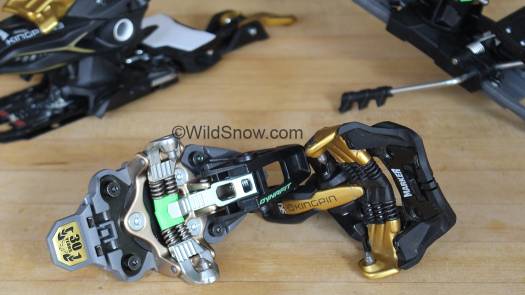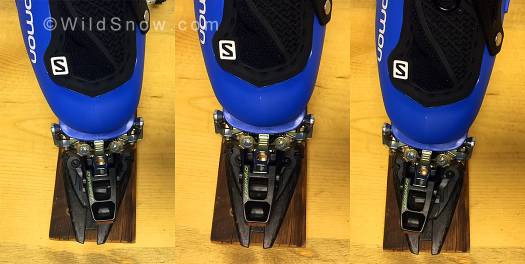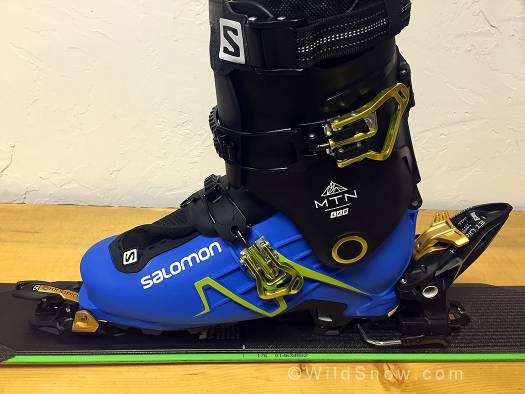Randy Young

Fight of the century? Dynafit Radical 2.0 vs Marker Kingpin? Or are these too different for a matchup? Click all images to enlarge.
An especially hot topic this fall has been the Marker Kingpin vs the Dynafit Radical 2.0. And the question is, “Which one is right for me?” Ski touring binding choice isn’t easy between what often seem to be similar gear and brands. Marker and Dynafit don’t make it any easier.
As a backcountry ski shop owner (Cripple Creek Backcountry), I spend a chunk of the winter going to trade shows and demos, testing all of the new boots, skis and bindings. Result: I can make a highly informed guess about the right gear for each unique backcountry skier. Here is how I’d attempt to sort out the Kingpin vs Radical dilemma for a customer.
Over the past several years, backcountry tech bindings have improved by leaps and bounds. Dynafit headed the charge, but other brands are catching up — or, perhaps have caught up? The fierce competition for the 2015-16 season is definitely Marker Kingpin vs Dynafit Radical FT 2.0. In one corner we have Dynafit: the old guard of the touring world who continues to up their game and release cutting edge gear. In the other corner we have Marker, a brand with a rich alpine heritage and some touring experience, jumping in with touring gear so good they’ve already cut themselves a large piece of the backcountry pie, even if they’re crashing an acquaintance’s birthday party.
Maker made a big splash last year with a “limited release” of the Kingpin and they were the first to tout a “tech” or “pin tech” binding with TUV-DIN certification to DIN/ISO standard 13992 for ski touring bindings. This was big news, but what was really catching everyone’s eye was the unusual appearance of this binding compared to previous tech bindings. The 6-pack spring set in the toe is certainly more confidence inspiring than traditional tech toes, and the heel is basically an alpine heel using a vertical release spring and lever that appears to be sourced from other Marker full-on alpine bindings. Lou had a frankenbinding like this in his workshop for years. I hope he got some of the patent rights on the Kingpin (but really I think it’s just for punching boots, shhh).
Kingpin offers the standard three climbing heights, with the usual touring lock at the toe. It comes with a DIN of 5-10 (aka Kingpin 10) or 6-13 (aka Kingpin 13) and has brake options to fit 75-100mm or 100-125mm. The binding has advertised weight of 730g with a brake and 650g without.
Lou did rudimentary, but noteworthy testing on the various tech binding toes and did not find the 6-pack spring to be significantly stronger than a standard 4-spring toe (he says he’s a bit mystified as to what purpose the extra springs serve, but he trusts Marker engineers to have “done what works.”)
Getting technical, Lou explains that in his opinion another engineering concern with Kingpin is that the more you depend on the heel unit to provide strong retention and calibrated release, the less spring action you can build into the toe due to unreliability of the boot toe tech fittings. Thus, while the Marker “six pack” looks good, there is a practical limit to how tight they can and should clamp your boot.
As a shop owner, I want to emphasize that when you depend on a tech binding to protect your legs from injury, you’re depending on the metal-to-metal ball-socket action of the binding toe pins. If that assembly catches or otherwise creates “jerky” release, the binding may not be providing the protection you’re assuming it does. The only way to test this is on the bench, both with hand checks and with a release calibration checker. Ski shops such as ours specialize in this, and keep our skills tuned by handling hundreds of binding-boot combinations each winter. Note that Dynafit Radical 2.0 is the ONLY tech binding that attempts to eliminate toe fitting problems from the equation. If it functions as intended the rotating toe could thus be a big deal.
The real possible advantage is in the Kingpin heel; it provides forward and downward pressure to the boot. You are not “floating” on heel pins, as some have described pin tech heels, but instead you have a positive force driving your boot into the ski. With a heel that behaves like an alpine heel, it’s perhaps no wonder Kingpin was able to pass certification for repeatable and predictable release and get the DIN/ISO certification. More, when you ski it you can feel the difference.
Now over to the snow leopard. Dynafit, try as they might to keep up with the Joneses, or rather the Markers, couldn’t get their binding into the “early retail release” game last year. But the Radical ST and FT 2.0 have arrived in full regalia this year. This binding was the featured item on the Dynafit homepage for a month at least, and for good reason. The Radical 2.0 has also received the TUV DIN/ISO 13990 certification.
Dynafit Radical ST 2.0 has an advertised weight of 599g with a DIN range of 4-10 while the Radical FT 2.0 has an advertised weight of 630g with a DIN range of 5-12. Both have varying brake width options (refer to comparison chart below). For the sake of comparison we’ll stick with including brakes in our weights, though Kingpin has a brakeless option and the brake could be cut off a Radical 2.0.
While having less consumer vetting than the Kingpin due to its late release, I can say with nearly 100% confidence that the Radical 2.0 advantage is the rotating toe. For the safety reasons we allude to above, but also for the exact opposite reason the Kingpin gets kudos. Instead of being ultra rigid, it’s a bit less so.
Here is one way of looking at it: A ski instructor came into our shop and said it is more difficult to learn to ski on traditional tech bindings because they are too rigid and ski too exact due to the way they attach at the toe. I agree. My knees and ankles quiver at the thought of the rigidity of tech bindings — especially since skiing with the toes locked has become so commonplace. However, the Dynafit Radical 2.0 toe has about 5mm of rotation to each side (and that’s only if you ski with the toes in ski mode; the rotation locks out if you engage the touring lock). Without depending on the boot fittings sliding over steel pins, this provides a more consistent, predictable elasticity and release. Presumably, the binding can handle sudden loading, i.e. landing a jump, and return to center without releasing. With this bit of rotation the tech toe is more dynamic to match a sport that is, well, dynamic.
Caveat is that the ski binding industry has for years attempted to build bindings with side (lateral) release at the heel — with limited success. Indeed, perhaps the only success of such bindings has been the Barthel tech binding design. As any experienced tech binding user can testify, even the best tech bindings up to this juncture are not alpine bindings. But almost none of those tech bindings had the unique pivoting tech toe of the Radical 2.0, which combines both spring action and rotation. Thus, we’re confident that Radical 2.0 could indeed be “alpine like.” (Dynafit Beast has a rotation toe, but we’re not covering Beast in this article.)

The rotating toe piece of Dynafit Radical 2.0. This range of motion is designed to be helpful under force i.e. landing after catching some air, skiing bumps.
So, how to decide which one is right for you?
First, let’s ask the important question: What’s the intended use? If you’re looking for a bomber everyday touring binding then my advice is always lighter is righter. Go with the Radical 2.0 —- if you have to carry something up 3,000 feet, you want the lightest set-up possible. Every gram counts. I weigh 160 lbs, ski aggressively (and it’s not pretty) and always have my bindings set to a release value (RV – DIN) of 8. I would go with the ST version since I do not need a higher range for a DIN setting. This choice saves me weight and a few dollars. Also, in full disclosure, I’ve skied Dynafit bindings in the backcountry for the last six years, and at the resort and backcountry for the last four. I am used to them and like the way they perform. If you’re used to traditional tech bindings and they work for you, why change? (Indeed, while we’re talking Radical 2.0 here, many ski tourers who enjoy minimalist tech bindings will no doubt be sticking with less complex and lighter bindings such as Dynafit Speed Radical.)
However, let’s say you were buying your first touring set-up or what would be your only set-up for the season. I would recommend Kingpin. The “step-in” performance of the alpine-style heel will be a benefit for days at the resort. Also, the Marker heel really allows you to power the tails of the skis to drive hard through a turn. This is especially important if you’re used to that same feel in an alpine binding, and don’t want to adjust your timing and technique for a softer heel. What is more, people tend to ski a more high-speed hard-driving style at the resort, and using a touring binding for such has always been problematic. Kingpin easily supports that style of skiing.
So, there you have it, hopefully a bit more insight into this season’s toughest head-to head gear match. And if you happen to be in the Roaring Fork Valley this season, stop by Cripple Creek Backcountry for a beer and some gear talk.
Beyond our regular guest bloggers who have their own profiles, some of our one-timers end up being categorized under this generic profile. Once they do a few posts, we build a category. In any case, we sure appreciate ALL the WildSnow guest bloggers!


